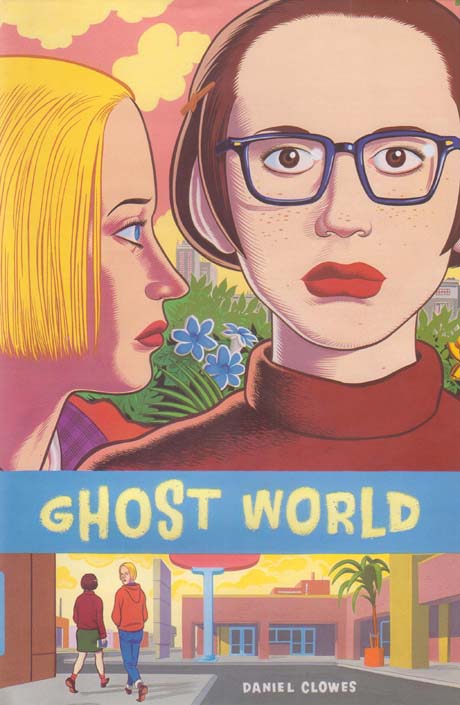
[Editorial Update: This is a post in a roundtable on Ghost World. The first, by kinukitty is here. The second by Charles Reece can be found here. Richard’s contribution can be found here and Noah’s take here.]
I bought a hardcover collection of Ghost World sometime in 1997 because I enjoyed Dan Clowes’ story in serialization when I first read it in the pages of Eightball. “Always nice to have a hardy, well-packaged edition for future reference,” I thought to myself. I don’t think I’ve cracked open the pages of the hardcover more than a couple of times in the intervening years.
The “episodic” nature of Ghost World is such that it benefits considerably from serialization. It comes across less well when read as a whole. Still, the first collected edition is a handsome affair made more meaningful by some additional artwork by the artist. The Wikipedia entry for Ghost World gives the following synopsis for the new art:
“The graphic novel includes five new drawings on the copyright, table of contents, acknowledgments, and other prefatory pages. These new drawings are tableaux of events in the characters’ lives that take place prior to the story, including their high school graduation, and a graveyard visit, presumably either for Rebecca’s parents (who are never seen or mentioned in the story, though the girl lives with her grandmother) or Enid’s mother (who is similarly absent). “
The main title page has the words “Ghost World” scrawled across the side of a one storey house reading almost like a label for the wispy inner lives half glimpsed through these portals- a reference to Clowes’ own suggestion that he first read these words scrawled on a building in Chicago.
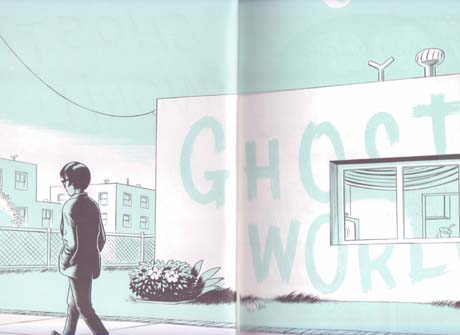
Further on, Clowes presents a scene of mourning and a tombstone for the publishers of his book (a time honored tradition in comics) and then a fuck you to any readers with an interest in delving further into his story.
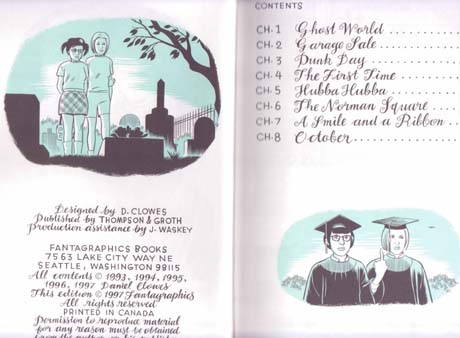
The Wikipedia entry omits to mention the endpaper illustrations which show a half hidden figure though a window…
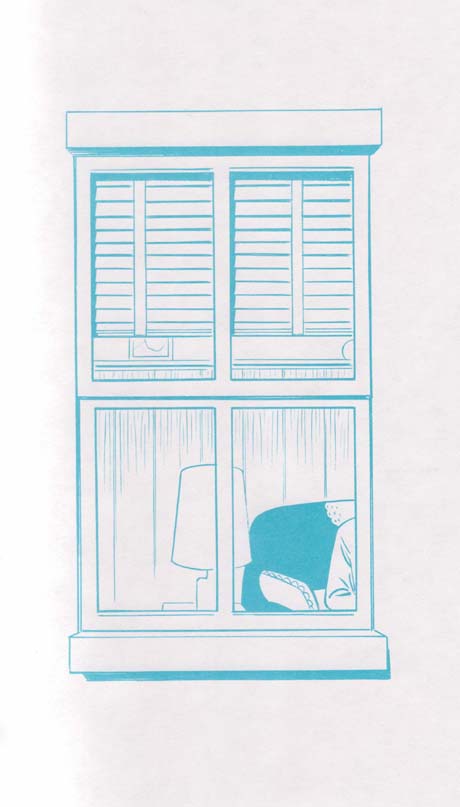
… and the dark side of the earth and the moon – a yin yang like illustration which mirrors the characters of Clowes’ book.
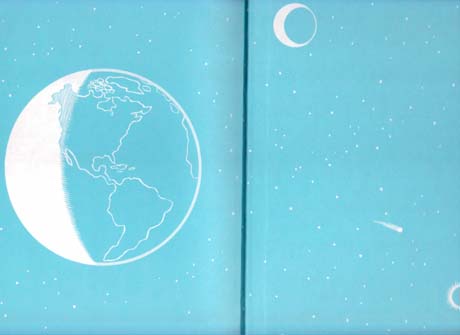
Clowes’ oeuvre is listed on a page showing Enid’s library. We know this because of the “Goofie Gus” toy lodged between the books. The library includes Clowes’ own inspiration for Ghost World namely, The World of Henry Orient, which thus presents itself as Enid’s own excuse for stalking people. There are books suggesting further study into insults and arcane sexual knowledge but most curious of all is Clowes’ addition of a copy of Oedipus Rex.

Opposite this illustration, on the right facing page, is a charming portrait of Enid as a child with the words, “for Erika”, written lovingly underneath . It has been said that Enid bears a physical resemblance to Erika Clowes, which would make Clowes’ illustration here a rather lovely portrait of his wife. On the other hand, the author has indicated that both Enid and Rebecca represent aspects of himself. If Enid is a proxy for Clowes, then one presumes that the rather adorable stuffed toy (I would suggest security object) must represent Clowes’ wife.
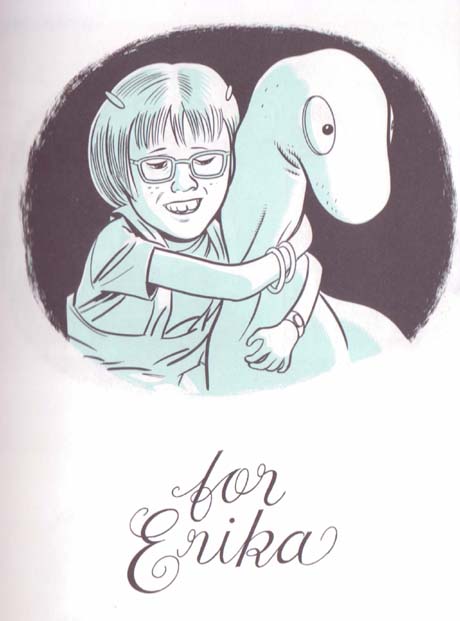
This has to be one of the most romantic images Clowes has ever drawn.
While Clowes is better known for his calculated cynicism, it is the most sentimental part of Ghost World which has stayed with me over the years. This would be the “Goofie Gus” chapter which is titled “Garage Sale” in the collected edition. Part of this has to do with the fact that it was this story which indicated that Ghost World was going to be something more; a departure from the cold calculation of his other shorts and Like a Velvet Glove Cast In Iron .
I enjoyed this story at its most basic level when I first read it over ten years back, remembering it for its brief but effective portrayal of the main character’s core of fragility. When End first meets Bob Skeetes at the beginning of the chapter, he offers to read her future and expresses little surprise that she is born on December 23rd 1979 and falls under the sign of “the goat” (i.e. Capricorn, a feminine sign and one marked by introversion, a trait which is clearly evident in Enid though she does her level best to obviate any misconceptions pertaining to this).
What follows is a confrontation with her own mortality (treated with callous curiosity) when a high school friend, Melorra, informs Enid and Rebecca about a mutual friend’s disfiguring and cancerous growth on her face. The pair then retire to a supermarket where they spot and track a couple which Enid had previously labeled “Satanists”.
They are, of course, anything but and are later seen to be buying Lunchables at the checkout counter, probably for their own personal consumption though one imagines that it is possible that the treats are meant for their child abductees and future sacrifices.
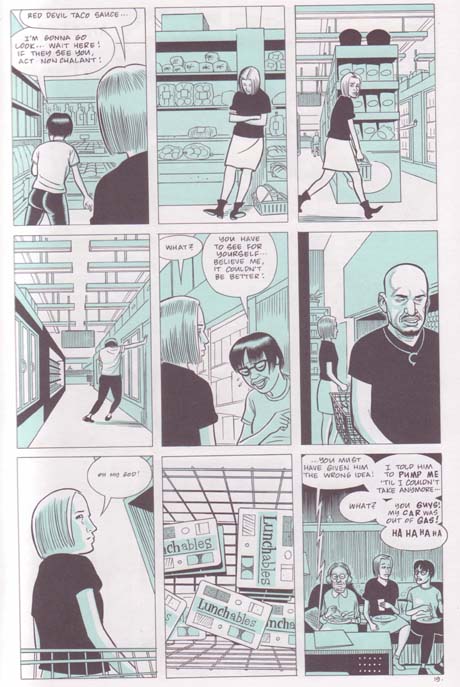
The former possibility is given credence by the proximity of this panel to another showing Enid and Rebecca consuming meals in front of the TV.
The Satanists may be a fantasy and no more than a squabbling couple but this fabrication belies a more deep seated and troubling fear – that a future life filled with the trappings of minor wickedness and pleasure may be nothing more than a longed for fiction. All that awaits Enid is a life of tedium and TV dinners in a small town, a life which Rebecca accedes to and Enid rejects at the end of the book.
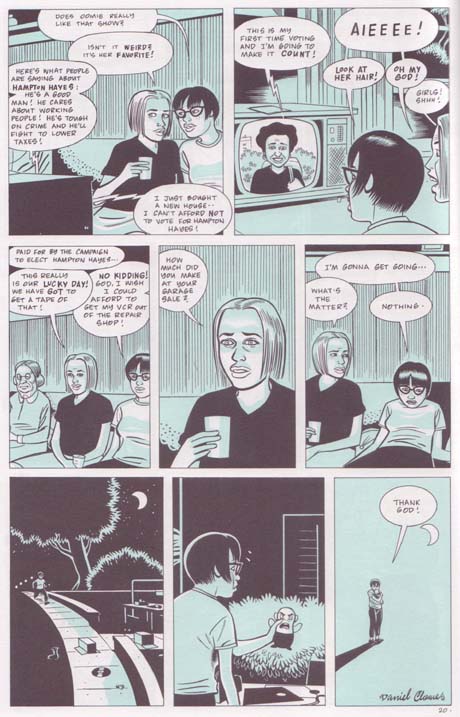
Why else would Enid rush back to find that last shred of comfort – a ridiculous doll representing all the possibilities of her intangible childhood? This hollow hope presages her final desperate escape at the end of the book.

Great stuff. The eating scene as it relates to the Satanists— astute.
Man, that kid and dinosaur panel is great. I’m not really arguing he’s an A + absolute top of the line cartoonist, but some of Clowes’ drawings just break my heart.
I don’t know, man. Satanists eat Lunchables, too.
The signed and numbered edition has a 3 color drawing of the window from the same angle featuring Rebecca leaning on the sill with the blinds rolled up. The partially visible figure occupies roughly the same position. It’s tipped in over the regular drawing on the endpapers, and I never knew the empty window drawing was there until I read this. I can send a jpeg upon request.
Pingback: THE BEAT » Blog Archive » Kibbles ‘n’ Bits — 12/18/09
That’s very interesting, Lou. Thanks for filling me in on this.